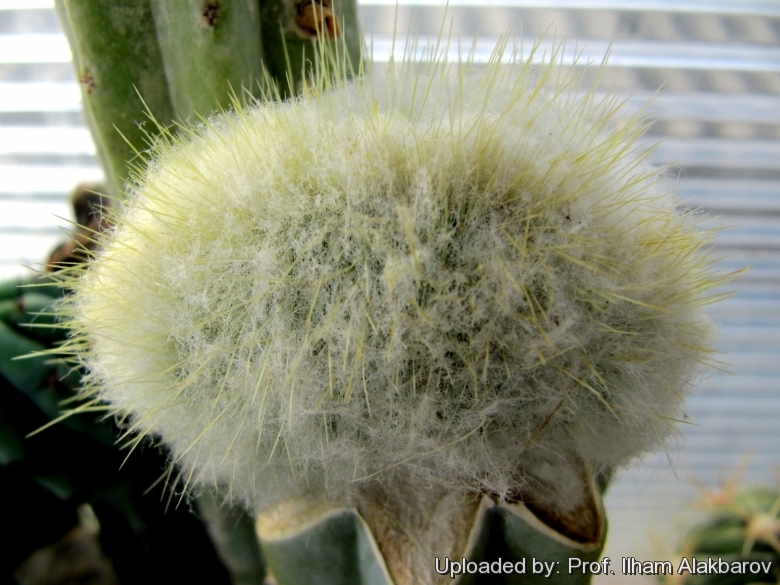Accepted Scientific Name: Espostoopsis dybowskii (Rol.-Goss.) Buxb. in Krainz
Kakteen (H. Krainz) Lief. 39: CVa. 1968 Krainz

Espostoopsis dybowskii f. cristata Photo by: Prof. Ilham Alakbarov
Origin and Habitat: Garden origin (Nursery produced cultivar).
Synonyms:
See all synonyms of Espostoopsis dybowskii
back
Accepted name in llifle Database:Espostoopsis dybowskii (Rol.-Goss.) Buxb. in KrainzKakteen (H. Krainz) Lief. 39: CVa. 1968Synonymy: 8
back
Common Names include:
ENGLISH: Cabega
PORTUGUESE (Português): Cabeça-branca, cabeça-de-velho, homem-velho, mandacaru-de-penacho
SWEDISH (Svenska): Ullbuskkaktus
Description: Espostoopsis dybowskiiSN|7944]]SN|7944]] is the only species in the Espostoopsis genus. It is a night blooming cereoid species, mainly branching near the base. The flowers are white, tubular and bell shaped.
Crested form: The crested form (Espostoopsis dybowskiiSN|7944]]SN|7944]] f. cristata) - despite to its beauty - is still very rare and sought after by collectors, for its unique features.
Stems: Fan shaped, up to 8 cm in thick, with white hairs completely obscuring them.
Ribs: Low.
Areoles: Furnished with matted yellowish wool and abundant white hairs covering the whole stem.
Central spines: 2-3, yellow or brown, erect, needle-like, 2-3 cm long.
Radial spines: Numerous, short, fine, hidden in the areolar hairs.
Fertile zone: Blooms are produced in a lateral cephalium, consisting of masses of long white wool.
Flowers: Nocturnal, shortly tubular-campanulate, white, to 4 cm long; pericarpels naked; floral tubes with very small scales less than 1 mm long, otherwise naked. Tepals short, white.
Fruits: Broadly ovoid, nearly naked, pale pink with white pulp, indehiscent, 2.5 cm in diameter; pericarp thick, floral remains persistent and becoming black.
Seeds: Black, oval to pear shaped, rough, tuberculate.
Subspecies, varieties, forms and cultivars of plants belonging to the Espostoopsis dybowskii group
Bibliography: Major references and further lectures
1) Taylor, N.P. 2013. Espostoopsis dybowskii. In: IUCN 2013. "IUCN Red List of Threatened Species. Version 2013.2. <www.iucnredlist.org>. Downloaded on 23 February 2014
2) Aldén, B., S. Ryman & M. Hjertson. “Våra kulturväxters namn - ursprung och användning. Formas, Stockholm (Handbook on Swedish cultivated and utility plants, their names and origin)” 2009.
3) Encke, F. et al. “Zander: Handwörterbuch der Pflanzennamen, 14. [= Austrocephalocereus dybowskii (Rol.-Goss.) Backeb.].” 1993
4) Hunt, D. “CITES Cactaceae checklist.” 1992
5) Taylor, N. & D. Zappi. “Cacti of eastern Brazil.” 2004.
6) Edward Anderson “The Cactus family” Timber Press, Incorporated, 2001
7) James Cullen, Sabina G. Knees, H. Suzanne Cubey "The European Garden Flora Flowering Plants: A Manual for the Identification of Plants Cultivated in Europe, Both Out-of-Doors and Under Glass" Cambridge University Press, 11/Aug/2011
8) David R Hunt; Nigel P Taylor; Graham Charles; International Cactaceae Systematics Group. "The New Cactus Lexicon" dh books, 2006
Cultivation and Propagation: These tropical cacti are not the easiest things to grow and aren’t plants for beginners.
Growth rate: It is a relatively rapidly growing given the best conditions.
Soils: It likes very porous standard cactus mix soil.
Repotting: The root system is weak and generally resents being repotted and can take a long time to re-establish. Use pot with good drainage.
Light: They prefer very bright light, not as much as the most arid growing cacti, but plenty nonetheless. Tends to bronze in strong light, which encourages flowering and heavy spine production.
Watering: They grow from April to October and cannot endure long stretches of total dryness, and also too much water will rot them, as their weak root systems tends to be inefficient at sucking up water from wet soil. Nonetheless, again as a result of their tropical origins, they need a fair amount of water, but allow the soil to dry quite a bit before watering again.
Fertilization: Do not feed in winter.
Crested growth: Unlike 'monstrose' varieties of plants, where the variation from normal growth is due to genetic mutation, crested growth can occur on normal plants. Sometimes it's due to variances in light intensity, or damage, but generally the causes are unknown. A crested plant may have some areas growing normally, and a cresting plant that looks like a brain, may revert to normal growth for no apparent reason. If you have any of the crested part left you need to remove the normal growth and leave the crested part behind this will need to be done regularly.
Hardiness: They rest from October to April but can’t stand cold, or even fairly cool temperatures, so is indispensable to keep them above 8-12°C at all times, severe damage or death occurring at temperatures that the great majority of cacti wouldn’t mind in the least and prefer more frequent water in winter than other cacti, say once a month. (but hardy to 4 C ° C for short periods). However warmth throughout the year will increase the grower's success (minimum 12° to 20° C during rest season).
Pests & diseases: It may be attractive to a variety of insects, but plants in good condition should be nearly pest-free, particularly if they are grown in a mineral potting-mix, with good exposure and ventilation. Nonetheless, there are several pests to watch for:
- Red spiders: Red spiders may be effectively rubbed up by misting the vulnerable plants every day
- Mealy bugs: Mealy bugs occasionally they develop aerial into the new growth among the wool with disfiguring results, but the worst types develop underground on the roots and are invisible except by their effects.
- Scales: Scales are rarely a problem.
- Rot: it is only a minor problem with cacti if the plants are watered and “aired” correctly. If they are not, fungicides won't help all that much.
Propagation: Exclusively by Seeds. Sow in February-march in a light, sandy, porous soil. Cover germinating tray with glass to prevent seed from drying out. Germination is most successful at a temperature of 18 to 22° C.











